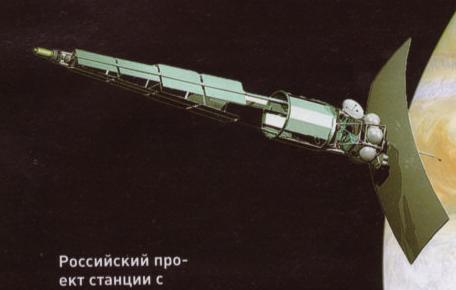In the illustration: a Russian project for a spacecraft with a nuclear reactor (left) and ion engines (right), has not yet received a name. Upon reaching the designated route, the radar antenna will open, which will block the nozzles of the engines

Not long ago, the Russian experts from the Keldysh Center and the Lavochkin Scientific-Industrial Association (NPO Lavochkin) developed a project of a research probe with a powerful ion engine, for the study of one of the largest Jupiter satellites - Europe.
The spacecraft will be equipped with a radar system, which will operate in the decametric range (a wavelength of tens of meters), with a power of 30 kilowatts and a surface area stretching to 100 square meters. A prototype of the antenna, an extremely light "umbrella", measuring 19 x 6 meters, was developed and tested in Israel by the special design office of the Moscow University of Electrical Engineering (OKB MPEI) together with the design office Salyut (KB Salyut). A similar antenna will be used to study the surface (and what is below) of Europa, as well as to send data to the Earth.
The ballistics of the project is not simple: the heavy probe will start the mission while rotating in a helical form with the help of ion engines, from a radiation-protected orbit, at an altitude of 800 km, to which it will be launched by the Proton-M launcher or by the perspective "Angara", which is developed by the Khronishev Center. After that, the "bus" with a mass of 18.9-21.5 tons leaves from the route closest to KDA. Within 330-490 days, the spacecraft will leave the gravity field of Kadu and begin the interplanetary journey. Here its "nuclear heart" will not stop working, and the spacecraft will continue to accelerate. The flight as Doa-Tzedek will last 1600-1800 days, and of those 530-570 days the engine will work - initially accelerating and then decelerating.
In the region of Jupiter's gravitational influence, the orbit of the spacecraft will change to a spiral that becomes narrower and narrower. The maneuvers for the probe to enter orbit around Europe will last between 280 and 435 days. The total journey will last 2200-2700 days, that is 6-7 years. The engine will have to work for about half of this time period! We note - all the previous spacecraft that were launched to the group of gas giants, were in an almost switched off state most of the time.
The calculations showed that to bring a 1000 to 1500 kg payload into orbit around "Europe" you need an electro-rocket propulsion device with a power of only 100 kilowatts, which can be provided by a small nuclear reactor.
As a result, a very large spacecraft weighing 7-8.5 tons will arrive in orbit around Europe! Its external appearance will not resemble the typical appearance of Russian-Soviet spaceships. It will be more like the spaceship from the MDB movies - an oddly shaped object that resembles a stack of boxes with equipment and large and complex parabolic antennas. In short, a nuclear spacecraft for deep space exploration!
The Russian project for the exploration of Europe was carried out as part of the "Federal Space Program for the period of 2006-2015?, which includes the application of nuclear technologies for the supply of electricity. First details of the concept were presented at the 55th IAC Conference, held in October 2004 in Vancouver, Canada, and at the 41st Assembly of the United Nations Scientific and Technological Sub-Conference in 2004.
Based on his article Igor Afenseev; From the scientific-popular monthly Vokrug Sveta ("Around the World"), October 2006 issue (2793). From Russian, Semyon Semyonov.

One response
Beautiful project.. Thank you very much..
You donated to us.